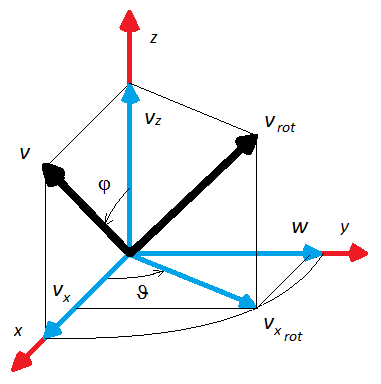Rodrigues' rotation formula
- This article is about the Rodrigues' rotation formula, which is distinct from the related Euler–Rodrigues parameters and The Euler–Rodrigues formula for 3D rotation.
In the theory of three-dimensional rotation, Rodrigues' rotation formula, named after Olinde Rodrigues, is an efficient algorithm for rotating a vector in space, given an axis and angle of rotation. By extension, this can be used to transform all three basis vectors to compute a rotation matrix in SO(3), the group of all rotation matrices, from an axis–angle representation. In other words, the Rodrigues' formula provides an algorithm to compute the exponential map from so(3), the Lie algebra of SO(3), to SO(3) without actually computing the full matrix exponential.
Statement
If v is a vector in ℝ3 and k is a unit vector describing an axis of rotation about which v rotates by an angle θ according to the right hand rule, the Rodrigues formula is
Derivation

Given a rotation axis represented by a unit vector k and a vector v to rotate about k by the angle θ,
is the component of v parallel to k, also called the vector projection of v on k, and
is the component of v orthogonal to k, also called the vector rejection of v from k.
Define
The vectors v⊥ and w have the same length, but w is perpendicular to both k and v⊥. This follows from
since k has unit length, is parallel to v∥∥ and is perpendicular to v⊥.
The vector w can be viewed as a copy of v⊥ rotated by 90° about k. Through trigonometry, one may now rotate v⊥ by θ around k to obtain v⊥rot. Consequently,
Moreover, v⊥rot is also the rejection from k of the vector vrot, defined as the desired vector, v rotated about k by the angle θ.
Since v∥∥ is not affected by a rotation about k, the projection of vrot on k coincides with v∥∥. Thus,
as stated.
Matrix notation
Representing v and k as column matrices, permits defining a matrix K as the "cross-product matrix" for the vector k, i.e.,
This matrix can be easily checked to have the property that
for any vector v. (In fact, K is the unique matrix with this property.)
Now, from the last equation in the previous sub-section, one may write
To simplify further, use the standard formula for the vector triple product,
with a = b = k, and c = v, to obtain
or
This amounts to (substituting the above equation in the last one for vrot),
resulting in the Rodrigues' rotation formula in matrix notation,
where R is the rotation matrix
Since K is defined in terms of the components of the rotation axis k, and θ is the rotation angle, R is the rotation matrix about k by angle θ. R is an element of the rotation group SO(3) of ℝ3, and K is an element of the Lie algebra so(3) generating that Lie group (note that K is skew-symmetric, which characterizes so(3)): In terms of the matrix exponential,
To see that the last identity holds, one notes that
characteristic of a one-parameter subgroup, i.e. exponential, and that the formulas match for infinitesimal θ.
For an alternative derivation based on this exponential relationship, see Axis–angle representation#Exponential map from so(3) to SO(3). For the inverse mapping, see Axis–angle representation#Log map from SO(3) to so(3).
See also
- Axis angle
- Rotation (mathematics)
- SO(3) and SO(4)
- Euler–Rodrigues formula
References
- Euler L., "Problema algebraicum ob affectiones prorsus singulares memorabile", Commentatio 407 Indicis Enestoemiani, Novi Comm. Acad. Sci. Petropolitanae 15 (1770), 75–106.
- Rodrigues O., "Des lois géometriques qui regissent les déplacements d' un systéme solide dans l' espace, et de la variation des coordonnées provenant de ces déplacement considérées indépendent des causes qui peuvent les produire", J. Math. Pures Appl. 5 (1840), 380–440.
- Don Koks, (2006) Explorations in Mathematical Physics, Springer Science+Business Media,LLC. ISBN 0-387-30943-8. Ch.4, pps 147 et seq. A Roundabout Route to Geometric Algebra'
External links
- Weisstein, Eric W., "Rodrigues' Rotation Formula", MathWorld.
- Johan E. Mebius, Derivation of the Euler-Rodrigues formula for three-dimensional rotations from the general formula for four-dimensional rotations., arXiv General Mathematics 2007.
- For another descriptive example see http://chrishecker.com/Rigid_Body_Dynamics#Physics_Articles, Chris Hecker, physics section, part 4. "The Third Dimension" -- on page 3, section ``Axis and Angle, http://chrishecker.com/images/b/bb/Gdmphys4.pdf







![\mathbf{K}=
\left[\begin{array}{ccc}
0 & -k_3 & k_2 \\
k_3 & 0 & -k_1 \\
-k_2 & k_1 & 0
\end{array}\right].](../I/m/ca6c0cc35fa0dd7a19869a3d48f98b66.png)









